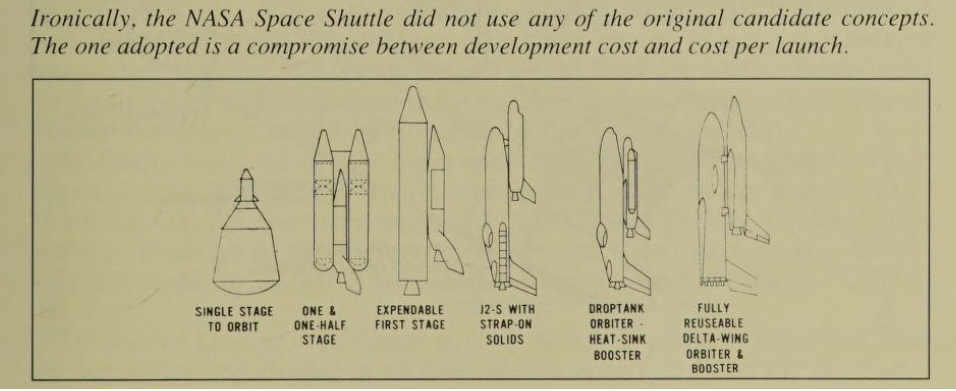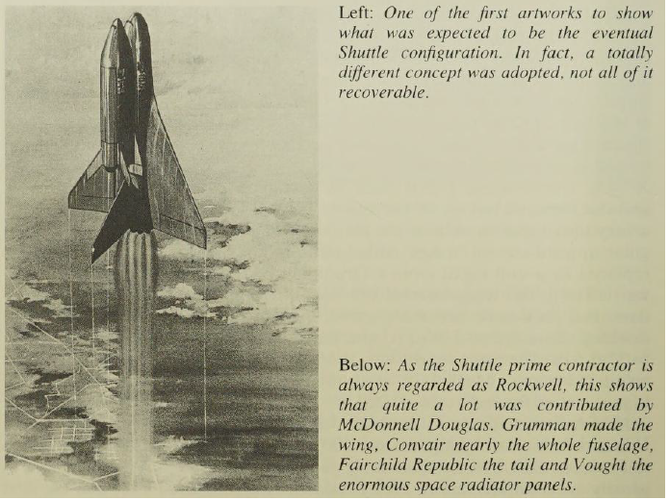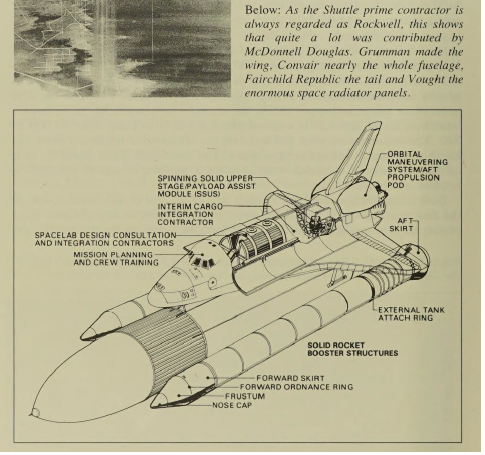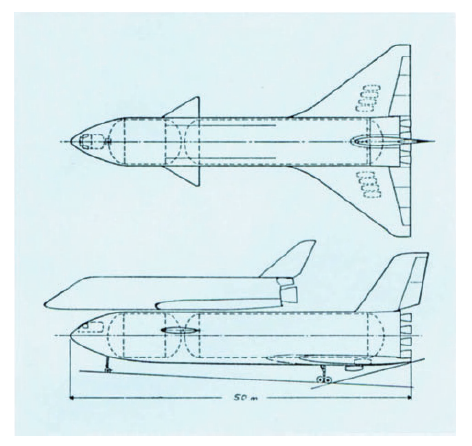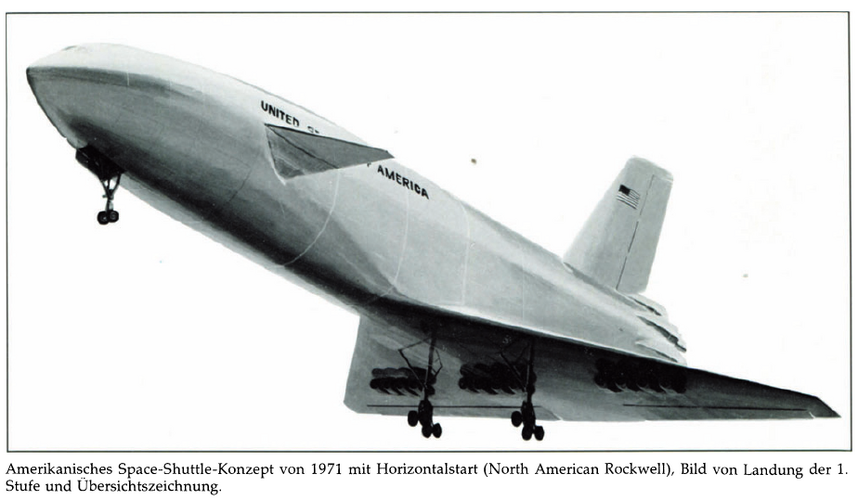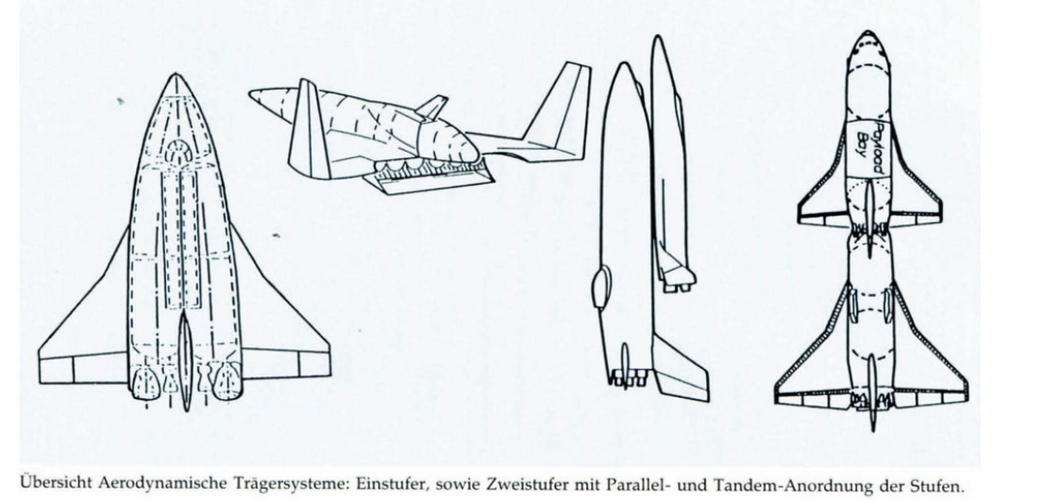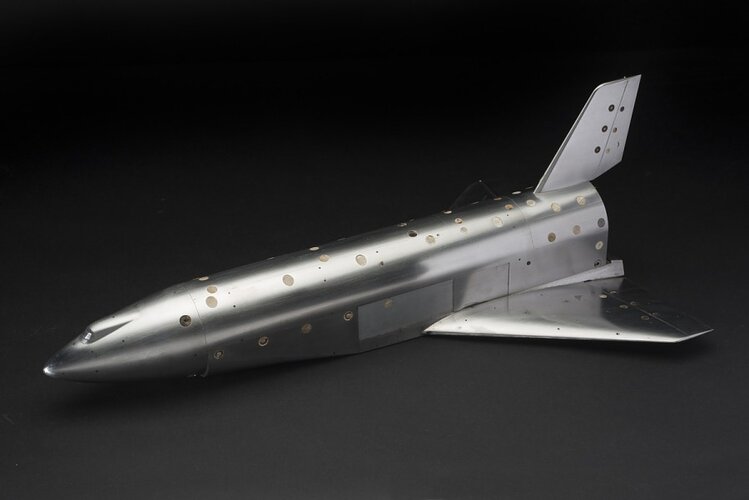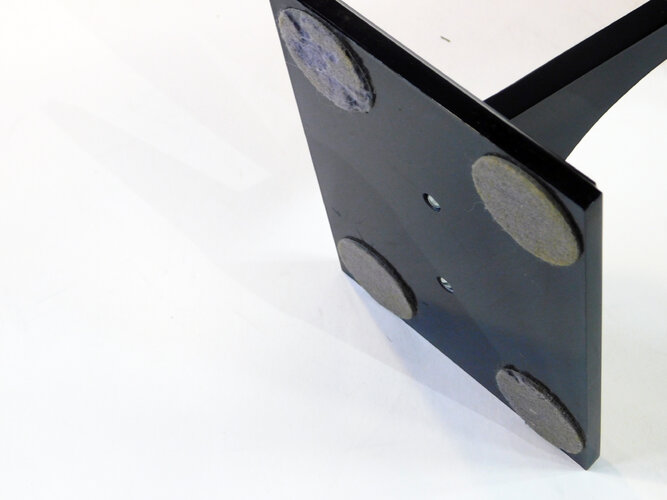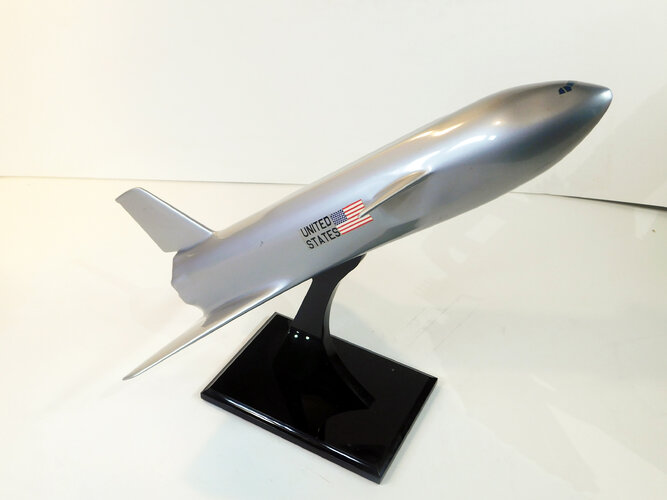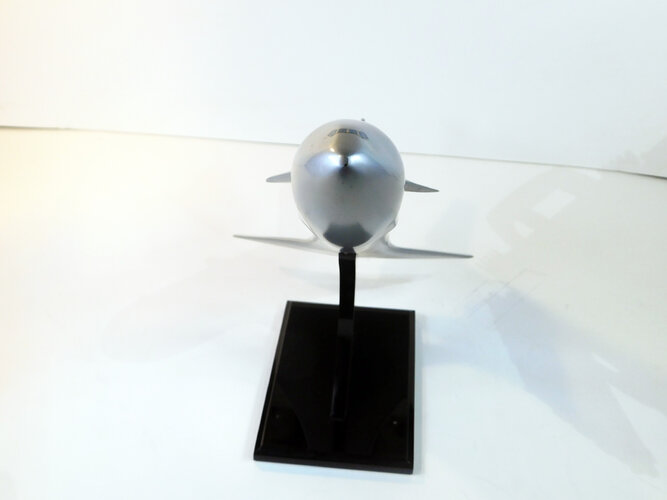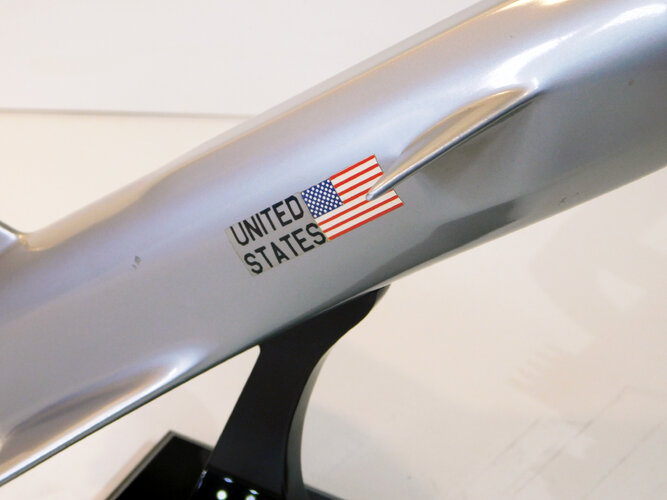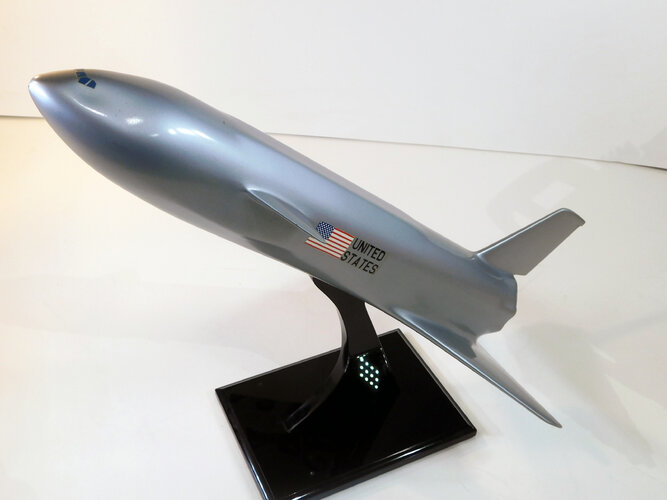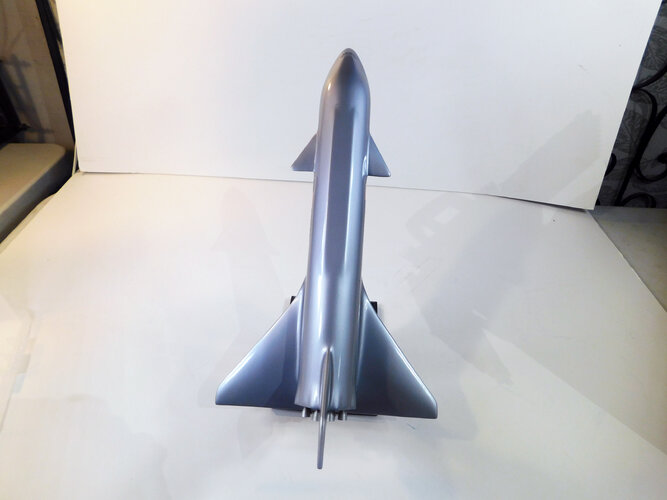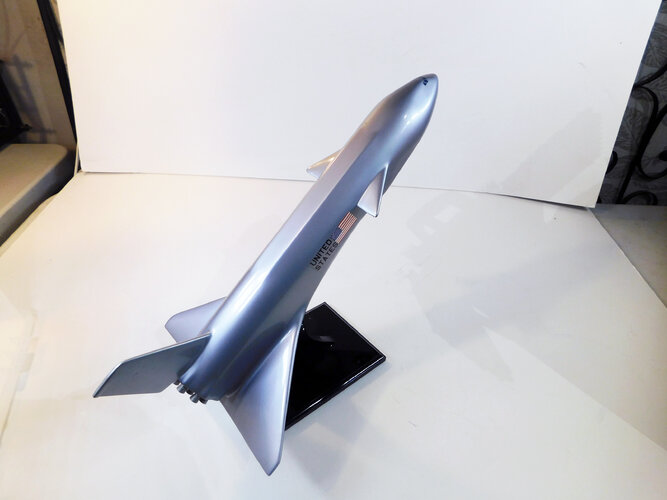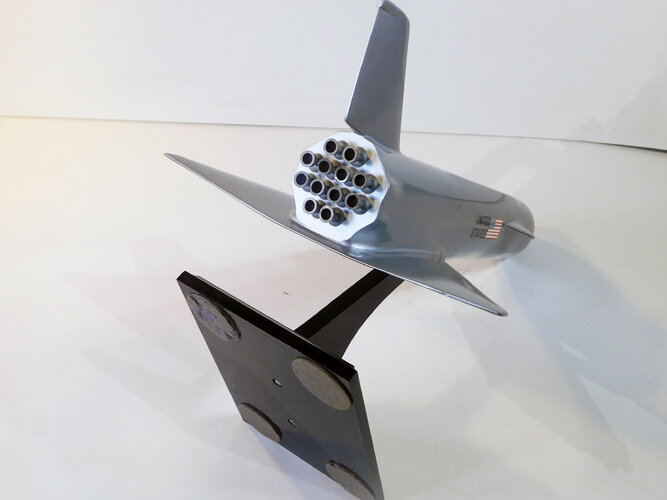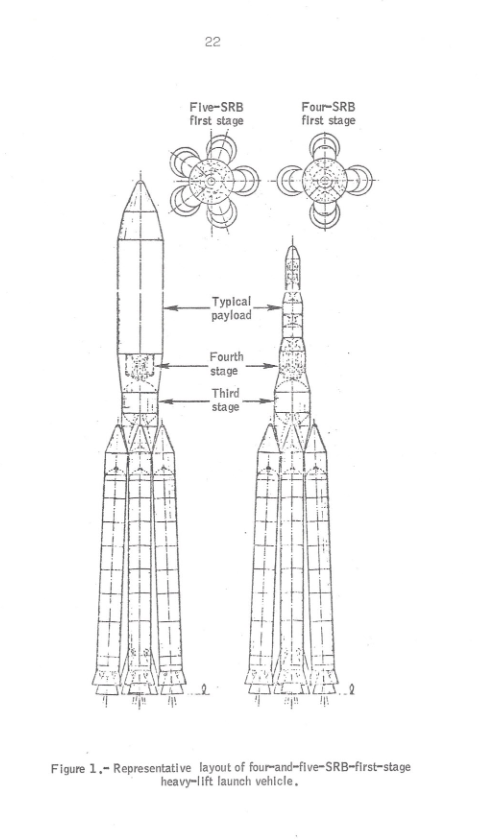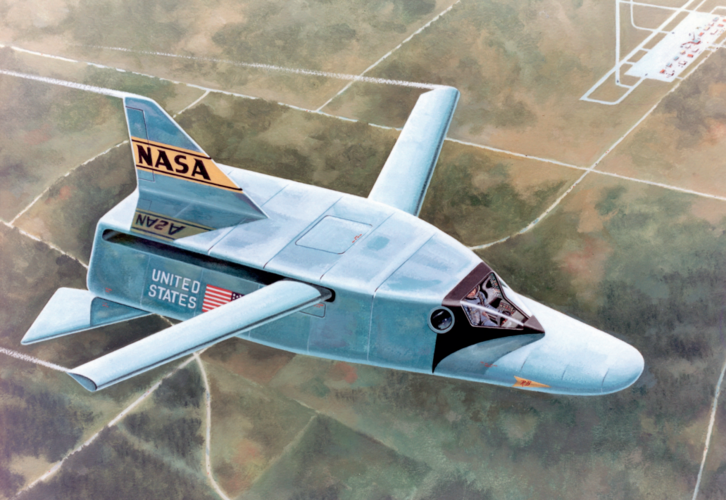The story of Frassanito and NASA is interesting. It started when he worked for legendary Raymond Loewy designer who had been hired by NASA to make Skylab a more human place. Early designs had astronauts screaming in horror and so George Mueller went to Loewy - and the young Frassanito.
You are using an out of date browser. It may not display this or other websites correctly.
You should upgrade or use an alternative browser.
You should upgrade or use an alternative browser.
Various US Reusable Launch Vehicles (RLV) Projects
- Thread starter PMN1
- Start date
- Joined
- 18 June 2009
- Messages
- 1,412
- Reaction score
- 2,494
I knew the details about the shuttle model because my first job as a model maker was for JF&A and later Fogg Models. In 1976, a friend and fellow model flyer was offered a job as a model maker, but he was happy being a gunsmith and told me I should go after this opportunity. I took a scratch built planked 4' Schleicher ASW-15 fuselage and a planked sailboat hull and those got me my first job as a model maker. I think Jack appreciated that I could work with curved surfaces and make drawings to describe them.
He was the industrial designer and one of the founders of the Datapoint Corporation, a uniquely non Silicon Valley early computer startup that could have been big but for the way things worked out. Most of my work was models of computer terminals, displays, and keyboards, along with soap dispensers and other product design projects. In the 80s I built 4' Space Station Modules with interiors and a full scale 8' tall 13' diameter Space Station section from Foamcore that was later installed at JSC.
I remember the Shuttle model coming into the office from Fogg and drooling over it. Jack later had me build up a 1/72 scale Shuttle that later was used in one of the Shuttle crew photos.
Jack could sketch beautifully and those sketches sold a lot of concepts. Small problem was that the sketches were far sexier than the real form factors would allow and I had to do a lot fiddling and fudging to get his designs to fit the real form factors they had to cover. He offered to teach me sketching and even put out the possibility of sending me to Art Center, but I was always more interested in airplanes than product design. I later got to work on airplanes with engineers and wouldn't care to work with designers again.
He was the industrial designer and one of the founders of the Datapoint Corporation, a uniquely non Silicon Valley early computer startup that could have been big but for the way things worked out. Most of my work was models of computer terminals, displays, and keyboards, along with soap dispensers and other product design projects. In the 80s I built 4' Space Station Modules with interiors and a full scale 8' tall 13' diameter Space Station section from Foamcore that was later installed at JSC.
I remember the Shuttle model coming into the office from Fogg and drooling over it. Jack later had me build up a 1/72 scale Shuttle that later was used in one of the Shuttle crew photos.
Jack could sketch beautifully and those sketches sold a lot of concepts. Small problem was that the sketches were far sexier than the real form factors would allow and I had to do a lot fiddling and fudging to get his designs to fit the real form factors they had to cover. He offered to teach me sketching and even put out the possibility of sending me to Art Center, but I was always more interested in airplanes than product design. I later got to work on airplanes with engineers and wouldn't care to work with designers again.
Last edited:
And Datapoint... witness of history... in 1968 -72 they were involved in the birth of Intel 4004 and 8008 microchips... that become legends (Microsoft 8080 286 386 486...)
Intel itself was born out of a scission of Fairchild Semiconductors, who build the Apollo Guidance Computer.
Folks, if you ever wonder how the "For all mankind" timeline got "d-mails" in the early 80's because of a different Apollo... look at Frassanito, Intel and Datapoint early histories This is the moment in history (1968, hell of a year) when NASA met the microchip.
Intel itself was born out of a scission of Fairchild Semiconductors, who build the Apollo Guidance Computer.
Folks, if you ever wonder how the "For all mankind" timeline got "d-mails" in the early 80's because of a different Apollo... look at Frassanito, Intel and Datapoint early histories This is the moment in history (1968, hell of a year) when NASA met the microchip.
Last edited:
- Joined
- 18 June 2009
- Messages
- 1,412
- Reaction score
- 2,494
While digging through the web to see what was out there about Jack, I found that the Datapoint CEO Phil Ray and some of the other founders had come from NASA. I would see Phil at autocrosses with his fat tired and flaired Porsche 911R and a very modified Porsche 550 Spyder. Jack had a Ferrari Dino and a De Tomaso Pantera. Jack told me that he ran a body shop before going to Art Center to become an industrial designer.
- Joined
- 18 June 2009
- Messages
- 1,412
- Reaction score
- 2,494
Datapoint history here. Not all of the computer revolution happened in Silicon Valley and a very significant factor in it happened in San Antonio, Texas. They could have been a contender!!!


Datapoint - Wikiwand
Datapoint Corporation, originally known as Computer Terminal Corporation (CTC), was a computer company based in San Antonio, Texas, United States. Founded in Ju...
www.wikiwand.com
Last edited:
- Joined
- 9 October 2009
- Messages
- 21,944
- Reaction score
- 13,576
- Joined
- 9 October 2009
- Messages
- 21,944
- Reaction score
- 13,576

Columbia (OV-102): RIGHT ON!
And 40 years since the start of that heralded “New Era”. Things, in the end, didn’t turn out to be so rosy though.

Columbia (OV-102): Innocence unleashed.
April 12, again & again. The able hands of John W. Young and Robert L. Crippen took Columbia on its incredibly bold first all-up maiden test flight. A NASA pretty basic drawing of the STS-1 mis…
- Joined
- 26 May 2006
- Messages
- 34,872
- Reaction score
- 15,733
The Convair Space Shuttle;
Attachments
numbers station
ACCESS: Restricted
Some of the best space art out there:I knew the details about the shuttle model because my first job as a model maker was for JF&A and later Fogg Models.
Maybe Elon could build that Convair version if nothing else works
He isn't going to ever
Maybe Elon could build that Convair version if nothing else works
- Joined
- 2 May 2007
- Messages
- 494
- Reaction score
- 1,947
More pics of same:Model, Space Shuttle, Lockheed Starclipper LS200-8 Stage-and-a-Half Concept,1:96 from the Smithsonian National Air and Space Museum Collections Database web site:
NASA studied this Lockheed Martin concept for a partially reusable space transportation system during the Shuttle research effort in 1969-1971. It featured a delta-wing orbiter vehicle flanked by two large external fuel tanks. It was called a stage-and-a-half vehicle because the orbiter would launch itself without a booster and fly all the way to orbit using its own rocket engines fed by the external fuel tanks (the half-stage), which would be jettisoned when empty. The reusable orbiter had retractable wings and air-breathing jet engines that deployed after reentry, enabling it to fly like an airplane to landing. NASA transferred a variety of concept models to the Museum after settling on the final Space Shuttle design.
(https://airandspace.si.edu/collecti...stage-and-a-half-concept196/nasm_A19740728000)
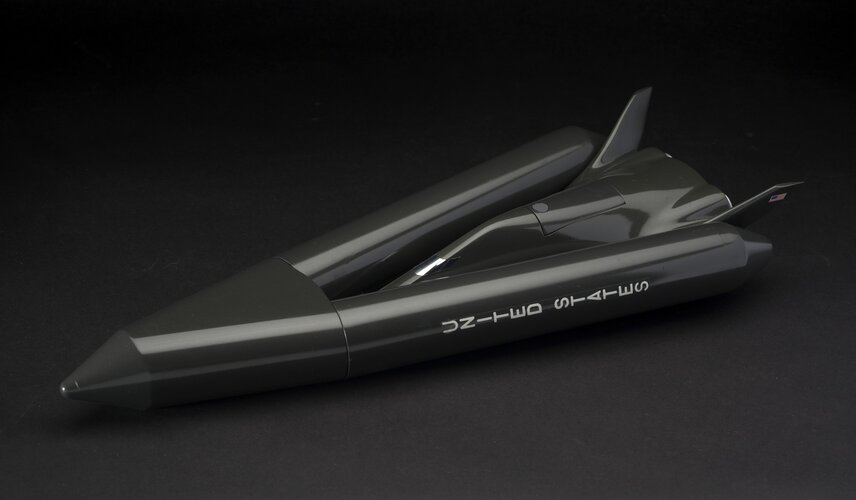
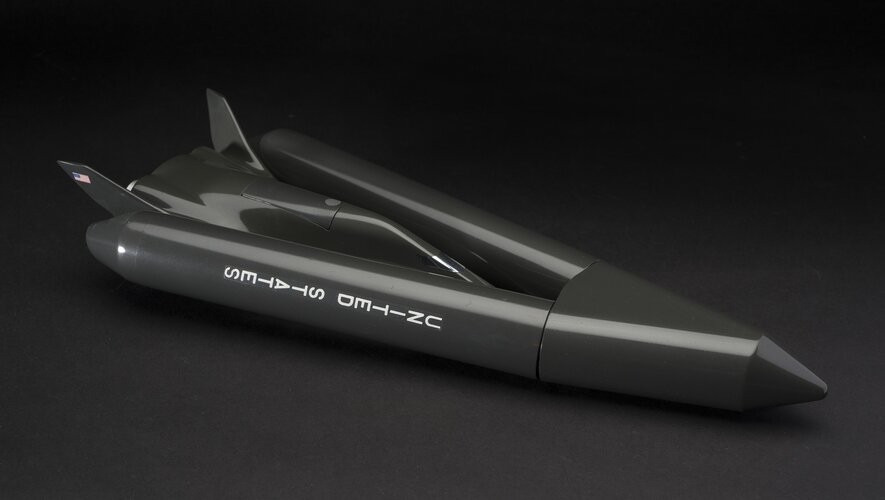
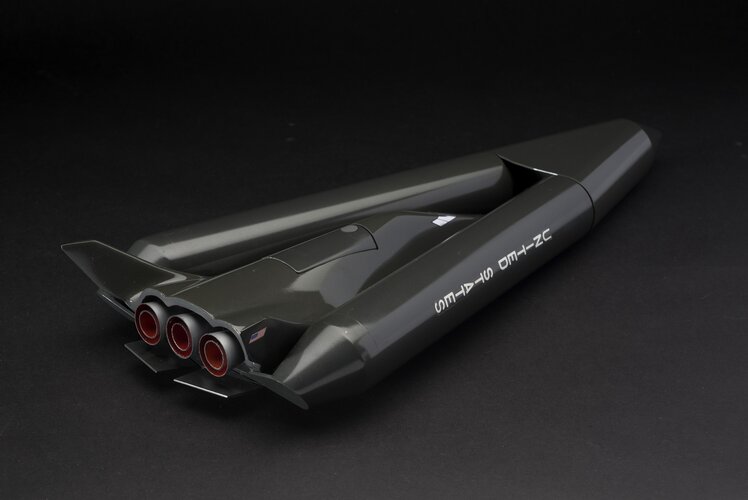
More pics of same:
As far as I'm concerned, this is one very inspiring and elegant design.
The triangular raft-like design makes me wonder if a combo Rogallo wing-inflatable heat shield would allow for tank recovery. This could be Dream Chaser 2.O now that Orbital Reef allows access to deeper pockets. A good exercise for those with art skills might be to draw shuttle external tanks of different sizes based on propellant. Hypergolics-zip tanks being the smallest.
- Joined
- 2 May 2007
- Messages
- 494
- Reaction score
- 1,947
But wait.. there's more!
(https://thedomestictraveller.files.wordpress.com/2019/03/nam-198.jpg)
![nam-198[1].jpg nam-198[1].jpg](data:image/svg+xml;charset=utf-8,%3Csvg xmlns%3D'http%3A%2F%2Fwww.w3.org%2F2000%2Fsvg' width='500' height='889' viewBox%3D'0 0 500 889'%2F%3E)
..and more generally for the post topic:

Some closer shots of other areas of the display here
(https://thedomestictraveller.files.wordpress.com/2019/03/nam-198.jpg)
![nam-198[1].jpg nam-198[1].jpg](https://www.secretprojects.co.uk/data/attachments/202/202592-5e6120dc12faddc8bd467052a76e1ec3.jpg)
..and more generally for the post topic:
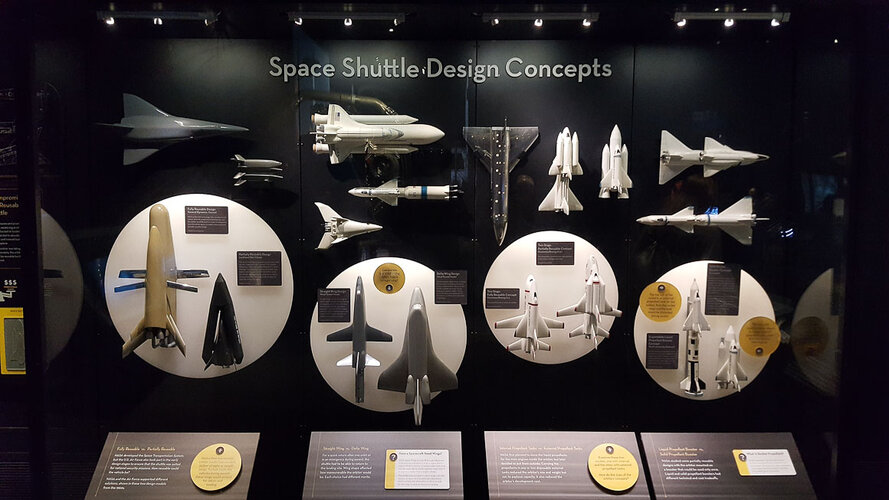
Some closer shots of other areas of the display here
Last edited:
Ah yes, the Smithsonian / NASM Shuttle models display. Some wonderful stuff there.
There were so many Shuttle configurations examined between 1968 and 1974 (when they dropped the jets from the familiar Shuttle Orbiter) there must have been hundreds of models out there, at NASA HQ, ten centers, the military, contractors, and countless other places.
There were so many Shuttle configurations examined between 1968 and 1974 (when they dropped the jets from the familiar Shuttle Orbiter) there must have been hundreds of models out there, at NASA HQ, ten centers, the military, contractors, and countless other places.
Capability for the production of large quantities of hydrazine has ended in the US, since Titan and Shuttle are no longer flying.The triangular raft-like design makes me wonder if a combo Rogallo wing-inflatable heat shield would allow for tank recovery. This could be Dream Chaser 2.O now that Orbital Reef allows access to deeper pockets. A good exercise for those with art skills might be to draw shuttle external tanks of different sizes based on propellant. Hypergolics-zip tanks being the smallest.
Last edited:
A shame, that. Storables need not be hypergolic...perhaps kero and HTP as Beal wanted. Still, a chart showing different size ETs to let one know how STS stacks with different propellant choices could have looked would be nice.
A shame, that. Storables need not be hypergolic...perhaps kero and HTP as Beal wanted. Still, a chart showing different size ETs to let one know how STS stacks with different propellant choices could have looked would be nice.
There was the idea for a Titan based "booster" for the ET which would provide a good idea, (no not really a "good" idea mind you
What is truly fascinating when reading Dennis Jenkins magnum opus on the Shuttle: how the familiar Shuttle Orbiter emerged (circa August 1971) from the MSC-036 to MSC-040A iterations.
With MSC-042 standing apart : with no engines and a huge booster - a Titan III-L in the role of Energiya.
"look ma ! An American Buran - before Buran !"
With MSC-042 standing apart : with no engines and a huge booster - a Titan III-L in the role of Energiya.
"look ma ! An American Buran - before Buran !"
martinbayer
ACCESS: Top Secret
- Joined
- 6 January 2009
- Messages
- 3,386
- Reaction score
- 3,881
Save for the throwaway tankage, if you take truly full reusability seriously...More pics of same:
As far as I'm concerned, this is one very inspiring and elegant design.
martinbayer
ACCESS: Top Secret
- Joined
- 6 January 2009
- Messages
- 3,386
- Reaction score
- 3,881
"The Earth is covered by two-thirds water and one-third space launch studies." Secretary of the U.S. Air Force Sheila A. Widnall, December 1992.What is truly fascinating when reading Dennis Jenkins magnum opus on the Shuttle: how the familiar Shuttle Orbiter emerged (circa August 1971) from the MSC-036 to MSC-040A iterations.
With MSC-042 standing apart : with no engines and a huge booster - a Titan III-L in the role of Energiya.
"look ma ! An American Buran - before Buran !"
Last edited:
No using that as a wet workshop! Before being a lifting body, Dream Chaser looked X-34 on a hybid Energia stack.What is truly fascinating when reading Dennis Jenkins magnum opus on the Shuttle: how the familiar Shuttle Orbiter emerged (circa August 1971) from the MSC-036 to MSC-040A iterations.
With MSC-042 standing apart : with no engines and a huge booster - a Titan III-L in the role of Energiya.
"look ma ! An American Buran - before Buran !"
- Joined
- 2 May 2007
- Messages
- 494
- Reaction score
- 1,947
North American Rockwell R-134B (I think?) model:
LARGE SPACE PLANE WIND TUNNEL MODEL.
Model of a delta-wing orbiter with twin wing-tip vertical tails, manufactured by North American Rockwell, c.1971. Wood and paint, 33 inches from nose to tail, wingspan 20 inches. Flag, "United States," and NASA decals. Displayed vertically on custom stand.
A product of the research that was taking place in the 1970s with the goal of producing a reusable shuttle. The present model was designed for wind tunnel tests, and is unusually large and striking.






 www.bonhams.com
www.bonhams.com
Sold for US$ 22,500 inc. premium (really!!?!)
The Space History Sale including Aviation
25 Mar 2013, 13:00 EDT
New York
LARGE SPACE PLANE WIND TUNNEL MODEL.
Model of a delta-wing orbiter with twin wing-tip vertical tails, manufactured by North American Rockwell, c.1971. Wood and paint, 33 inches from nose to tail, wingspan 20 inches. Flag, "United States," and NASA decals. Displayed vertically on custom stand.
A product of the research that was taking place in the 1970s with the goal of producing a reusable shuttle. The present model was designed for wind tunnel tests, and is unusually large and striking.
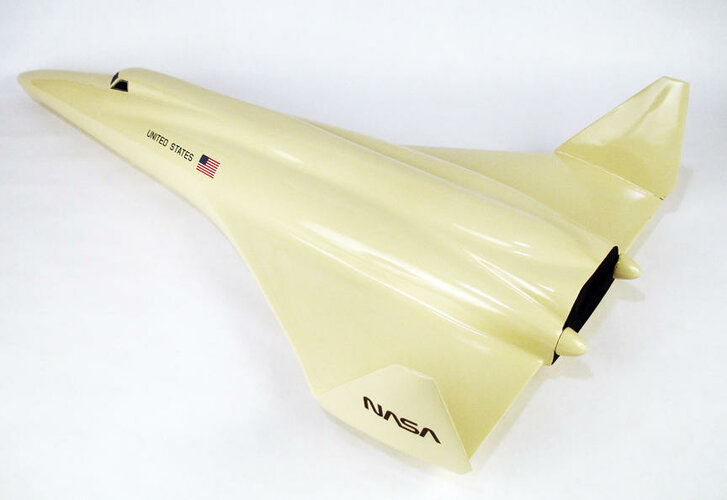
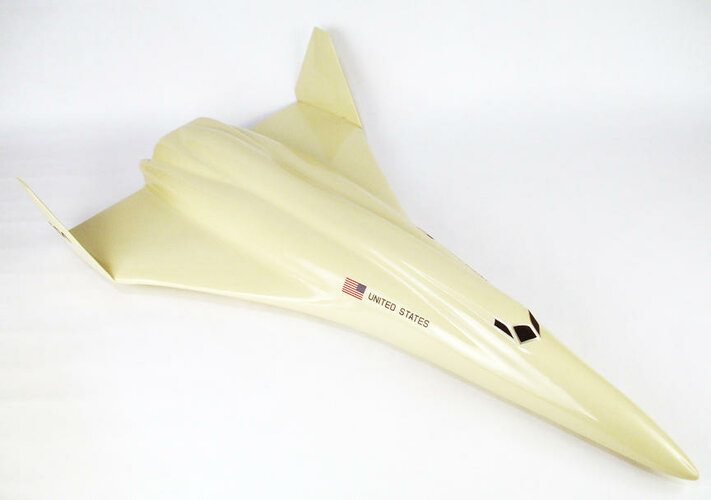
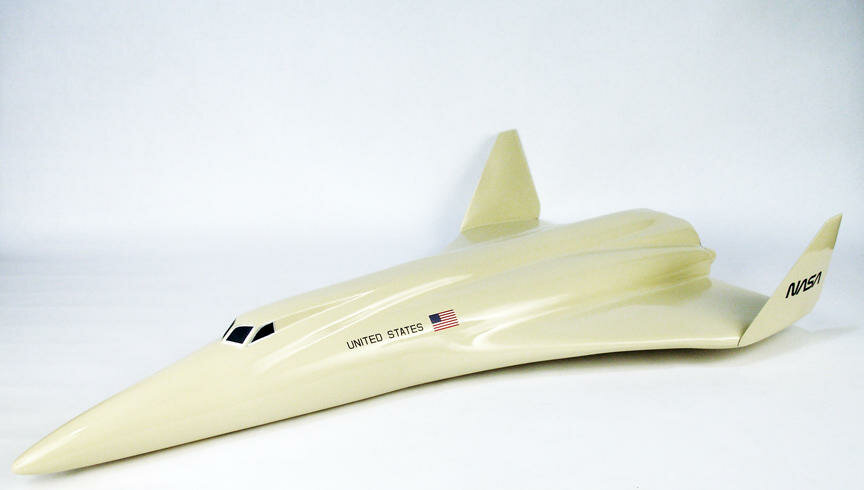
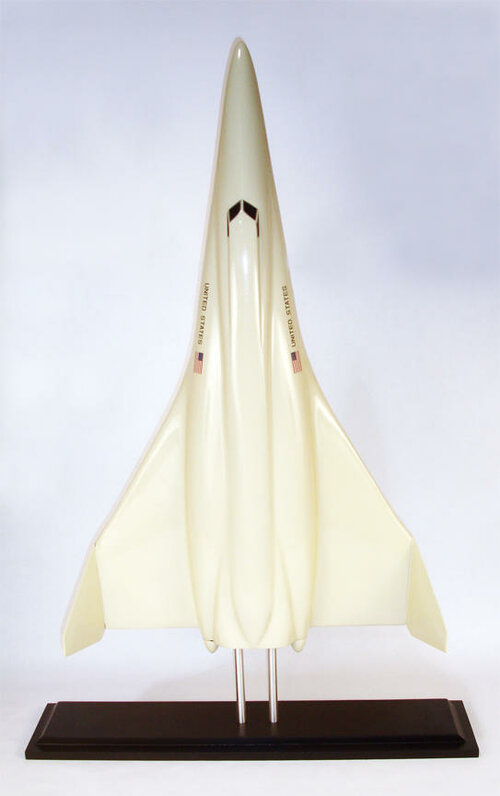
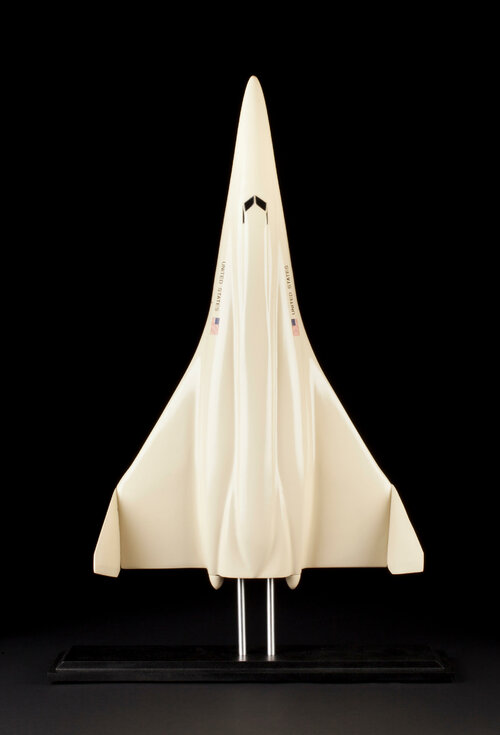

Bonhams : LARGE SPACE PLANE WIND TUNNEL MODEL. Model of a delta-wing orbiter with twin wing-tip vertical tails, manufactured by North American Rockwell, c.1971. Wood and paint, 33 inches from nose to tail,
Model of a delta-wing orbiter with twin wing-tip vertical tails, manufactured by North American Rockwell, c.1971. Wood and paint, 33 inches from nose to tail, wingspan 20 inches. Flag, "United States," and NASA decals. Displayed vertically on custom stand. A product of the research that was...
Sold for US$ 22,500 inc. premium (really!!?!)
The Space History Sale including Aviation
25 Mar 2013, 13:00 EDT
New York
Last edited:
I really hate being poorNorth American Rockwell R-134B (I think?) model:
LARGE SPACE PLANE WIND TUNNEL MODEL.
Model of a delta-wing orbiter with twin wing-tip vertical tails, manufactured by North American Rockwell, c.1971. Wood and paint, 33 inches from nose to tail
Sold for US$ 22,500 inc. premium (really!!?!)
The Space History Sale including Aviation
25 Mar 2013, 13:00 EDT
New York
TimothyC
Arnie Holmes
- Joined
- 31 March 2010
- Messages
- 30
- Reaction score
- 55
I will be getting this scanned (I have access to a proper scanner, but the phone camera was faster for this) and uploaded soon, as I've yet to find a copy of JSC Internal Note 74-FM-80 (sometimes noted as 74-FM-080) Space Shuttle Derived Heavy-Lift Launch Vehicle (1974-11-20) online. Special thanks to John McNeely who not only co-wrote the note, but was kind enough to send me his copy!
Yes, it's like a BIG SRB-X, but a decade earlier. Payload for the five-booster version is ~125k lbm to a 500 nautical mile circular orbit at 28.5° orbit, or 100klbm to a 500 nautical mile circular orbit at 90°. The four-booster version has payload capabilities about 20% lower.


Yes, it's like a BIG SRB-X, but a decade earlier. Payload for the five-booster version is ~125k lbm to a 500 nautical mile circular orbit at 28.5° orbit, or 100klbm to a 500 nautical mile circular orbit at 90°. The four-booster version has payload capabilities about 20% lower.
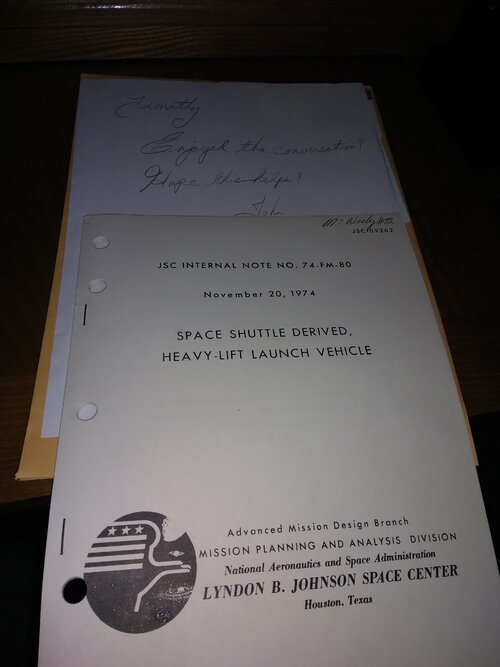
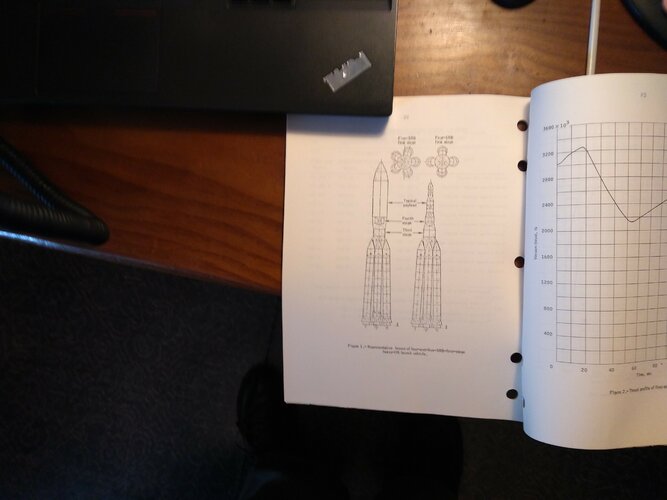
Last edited:
TimothyC
Arnie Holmes
- Joined
- 31 March 2010
- Messages
- 30
- Reaction score
- 55
And here we go. Thanks to John T. McNeely for not only allowing me to interview him, but also for sending me his personal copy of the internal note.
Because the forum does not like the nearly 11 meg file, I'm linking to where I've posted it on NSF. I hope this isn't out of line.
JSC Internal Note 74-FM-80
Space Shuttle Derived, Heavy-Lift Launch Vehicle
November 20th, 1974
Because the forum does not like the nearly 11 meg file, I'm linking to where I've posted it on NSF. I hope this isn't out of line.
JSC Internal Note 74-FM-80
Space Shuttle Derived, Heavy-Lift Launch Vehicle
November 20th, 1974
Attachments
athpilot
Fly me to the moon...
- Joined
- 18 November 2012
- Messages
- 411
- Reaction score
- 452
Cool animation of the Lockheed LS-200 Star Clipper:
<iframe width="560" height="315" src="
View: https://www.youtube.com/embed/9BF4wNv4pOc
" title="YouTube video player" frameborder="0" allow="accelerometer; autoplay; clipboard-write; encrypted-media; gyroscope; picture-in-picture" allowfullscreen></iframe>
<iframe width="560" height="315" src="
" title="YouTube video player" frameborder="0" allow="accelerometer; autoplay; clipboard-write; encrypted-media; gyroscope; picture-in-picture" allowfullscreen></iframe>
nivek626
ACCESS: Restricted
- Joined
- 12 June 2008
- Messages
- 27
- Reaction score
- 42
Found Some Artwork for MURP at https://d2r6h7ytneza1l.cloudfront.n...20210517T133634Z_Bisney_Pickering_Excerpt.pdf
Attachments
Now THAT is a platypus. On a side note...was there a spaceplane contender that came closest to getting the "Future Notional Horizontal Launch Area" actually built up? With new fusion magnets-sled-launch concepts might be due for another look-especially methane concepts since nearby L-49 looks to be built for Starship. Were I a billionaire-I would love to be crew shuttle to a cargo only Starship. There is a potential two-prong approach here. Any papers on sled-launch methalox designs that could share -49's coming infrastructure? And-has anyone thought to repurpose upward slanted runways like Courchevel Altiport for sled-launch? With better choppers altiports can find new uses.
Last edited:
Sled launches are non starters and nobody is working themNow THAT is a platypus. On a side note...was there a spaceplane contender that came closest to getting the "Future Notional Horizontal Launch Area" actually built up? With new fusion magnets-sled-launch concepts might be due for another look-especially methane concepts since nearby L-49 looks to be built for Starship. Were I a billionaire-I would love to be crew shuttle to a cargo only Starship. There is a potential two-prong approach here. Any papers on sled-launch methalox designs that could share -49's coming infrastructure? And-has anyone thought to repurpose upward slanted runways like Courchevel Altiport for sled-launch? With better choppers altiports can find new uses.
Horizontal Launch Area was another airstrip.
Sled launches are non starters and nobody is working themNow THAT is a platypus. On a side note...was there a spaceplane contender that came closest to getting the "Future Notional Horizontal Launch Area" actually built up? With new fusion magnets-sled-launch concepts might be due for another look-especially methane concepts since nearby L-49 looks to be built for Starship. Were I a billionaire-I would love to be crew shuttle to a cargo only Starship. There is a potential two-prong approach here. Any papers on sled-launch methalox designs that could share -49's coming infrastructure? And-has anyone thought to repurpose upward slanted runways like Courchevel Altiport for sled-launch? With better choppers altiports can find new uses.
Horizontal Launch Area was another airstrip.
Incorrect, heavy snow the last few days and MANY people are here are working on sled launch.. often whether they want to or not. (Black ice is a thing after all
Happy Holidays folks!
Randy
Nik
ACCESS: Top Secret
- Joined
- 15 July 2009
- Messages
- 1,269
- Reaction score
- 1,062
Tangential, would 'StarClipper' external tanks have solved the X-33 issues with those internal tanks being a 'composite too far' at time ? With part of tankage outside, internal shapes could be much simpler and lighter, incidentally helping with c/g issues. Likewise, the 'traditional' external tankage design would not be an engineering challenge, while providing ample space in nose for recovery chute...
Or did the big Aerospike's significant thrust/weight shortfall doom the project ?
IIRC, Aerospike failed to scale well, proved disconcertingly under-powered, while requiring much heavier materials than anticipated.
By analogy with several WW2 aircraft designs that failed because their intended engines failed to 'come good', and replacement would require too many major design changes...
FWIW, is any-one doing anything with aerospike design ? Have advances in CFD modelling confirmed it was a dead-end ??
Or did the big Aerospike's significant thrust/weight shortfall doom the project ?
IIRC, Aerospike failed to scale well, proved disconcertingly under-powered, while requiring much heavier materials than anticipated.
By analogy with several WW2 aircraft designs that failed because their intended engines failed to 'come good', and replacement would require too many major design changes...
FWIW, is any-one doing anything with aerospike design ? Have advances in CFD modelling confirmed it was a dead-end ??
I seem to remember an annular aerospike test a Parabolic Arc not long ago-I wonder if you could couple that with RENE and Gnom type air-breathing solids in an annular-torus type mold...something that could slide out from around a central stage...
no, it would created a worse problem than it would solve.. All that tank acreage directly shedding onto the StarClipper TPS.Tangential, would 'StarClipper' external tanks have solved the X-33 issues with those internal tanks being a 'composite too far' at time ? With part of tankage outside, internal shapes could be much simpler and lighter, incidentally helping with c/g issues. Likewise, the 'traditional' external tankage design would not be an engineering challenge, while providing ample space in nose for recovery chute...
Anyways, using Lithium Aluminum tanks in the same shape would have fixed the leakage issue on X-33 with less mass.
Similar threads
-
-
-
-
Candidate Space Shuttle Orbiters Wind Tunnel Studies 1969 NASA Langley Research
- Started by Hanse
- Replies: 2
-

